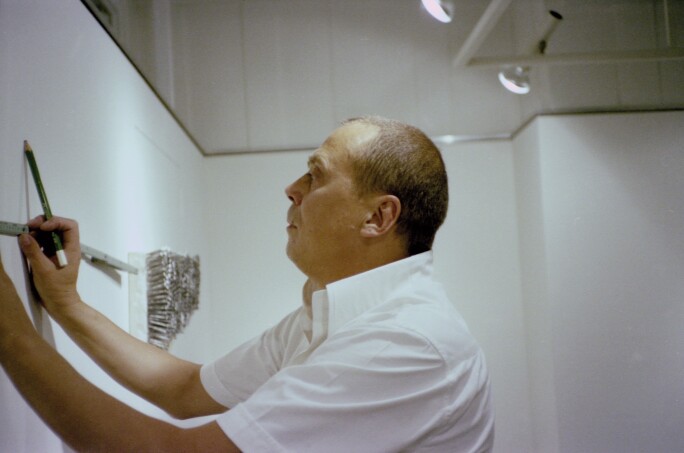Günther Uecker, an eminent figure in contemporary art, is renowned for his profound exploration of texture and materiality, particularly through his innovative use of nails. His Vision Rapperswil aus dem Quadrat exemplifies his unique artistic vision, characterized by a striking horizontal structure that harmoniously follows the contours of the wooden backing board. This work not only showcases Uecker's masterful craftsmanship but also invites viewers to engage deeply with its tactile qualities. The work was created as part of the 'Vision Rapperswil aus dem Quadrat' series in 1982. It forms part of a portfolio comprising woodcut and print. In an artist's statement, Uecker states:

"Vision Rapperswil: My ideas of a place at the end of a lake, surrounded by distant Alps, led me to Vision Rapperswil, which has now become the subject of this book. A horizontal reflecting surface of water is a visual challenge in the midst of jagged, towering mountains. The reflection becomes one with reality, it represents a new reality. A reality of our fantastic vision. My spatial splinters cut from a square wooden panel have straight edges due to the four outer sides of the square. If only all the side boundaries are brought to a horizontal line, analogies to these ideas of landscape arise." (translated from german)
As a vital member of the ZERO group, Uecker played an instrumental role in shaping this influential art movement, which emerged in the late 1950s and sought to break free from traditional artistic conventions. ZERO artists were united in their desire to explore the relationships between light, space, and materials, often emphasizing the transformative power of art to transcend the physical and evoke emotional responses. Uecker's work, particularly through his use of nails and other materials, exemplified this ethos, engaging viewers in a dialogue about the nature of perception and the sensory experience of art. Uecker himself articulated this philosophy, stating:
“My objects are spatial realities, zones of light. I use mechanical means in order to overcome the subjective gesture, to objectify it, and to create the situation of freedom”

The composition of the present work is marked by an intricate arrangement of nails, each meticulously placed to create a dynamic interplay of light and shadow. The horizontal orientation evokes a sense of calm and stability, inviting contemplation as it draws the eye across the surface. The nails, with their varied depths and orientations, create a mesmerizing rhythm that captivates the viewer, engaging both the visual and tactile senses. This deliberate arrangement reflects Uecker's interest in the interplay between structure and randomness, as well as his exploration of the transformative potential of materials.